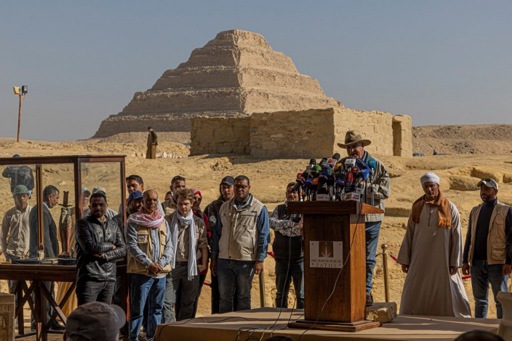Egypt on Thursday unveiled four tombs of pharaonic dignitaries and a mummy more than 4,000 years old near Cairo, in the latest in a series of discoveries announced with great fanfare by a country anxious to lure tourists back.
Archaeologists uncovered the tombs in the necropolis of Saqqara, known for the famous step pyramid of Pharaoh Djoser. The deep cavities decorated with colourful scenes of everyday life were sealed during the 5th and 6th dynasties, between 2500 and 2100 BC.
They “served as the final resting place of Khnumdjedef, high priest of Pharaoh Unas, whose decorated pyramid is located nearby, Meri, keeper of the king’s secrets, Messi, high priest of Pharaoh Pepi I, and Fetek, scribe and judge,” Egyptian archaeologist Zahi Hawass told the press.
Mummy covered in gold
During the excavation, 15 metres underground, archaeologists found a limestone sarcophagus “in the exact state in which the ancient Egyptians had left it 4,300 years ago,” said Mr Hawass.
When they opened it, they discovered a mummy covered in gold, “one of the oldest and best preserved in Egypt apart from the royal mummies,” he said, his head covered as usual by his famous Indiana Jones hat.
The necropolis of Saqqara, a little more than 15 kilometres south of the famous pyramids on the Giza Plateau, is a UNESCO World Heritage site because the pyramid of Djoser, built around 2,700 BC by the architect Imhotep, is considered one of the oldest monuments on the face of the earth.
The remains of ‘an entire Roman city’
Egypt has revealed several major discoveries in recent months, mainly at Saqqara but also at Luxor. On Tuesday, Cairo announced the discovery in this southern city, the Thebes of the Pharaohs, of the remains of “an entire Roman city” dating back to the first centuries AD.
For some experts, these announcements are more political and economic than scientific. The country of 104 million people is in serious economic crisis and is counting on tourism to help it recover. Its government is aiming for 30 million tourists a year by 2028, as against 13 million before Covid-19.

